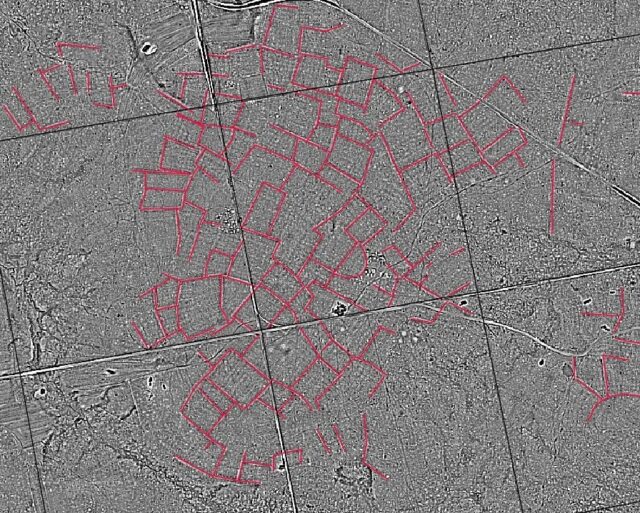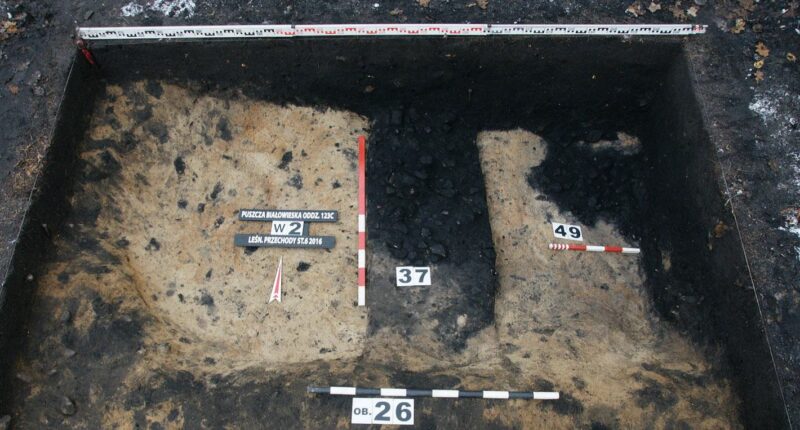Recent LiDAR scans of Białowieża Forest have revealed an unexpected network of linear structures that started to challenge our understanding of the region's past and of the ways in which forest areas are preserved and changed. Those linear objects stretch kilometers across the landscape and are sometimes argued to serve as a technology from early middle ages. These straight lines, invisible from ground level, have sparked scientific debate and public curiosity about the ways in which we look upon national reserves and forest areas worldwide.
Preliminary findings suggest these structures may predate recorded history in the region. Their purpose and origin remain subjects of intense academic debate.
Archaeological evidence now also indicates some form of human involvement in creating these linear features. The precision of their arrangement and the forms in which they were made does not suppose natural explanation and makes them likely to be an early human-made object.
Theories range from ancient boundary markers to astronomical alignments. Some researchers propose they formed part of a communication network similar to ones we discuss in other articles and research notes.. Long hidden beneath centuries of forest growth and nature development, these structures remained undetected until advanced technology revealed their presence.
Every civilization leaves marks upon the landscape. These particular patterns suggest a sophisticated understanding of geometry and spatial relationships. And recent ground surveys do confirm the artificial nature of these linear objects. Their consistent dimensions and precise angles indicate deliberate design rather than natural formation.
Scientists from Warsaw University have begun systematic documentation of all identified linear features. Their preliminary mapping reveals geometric relationships between seemingly unrelated segments.
Each new discovery raises more questions than answers about the original purpose of this system. The linear objects appear to form a cohesive network across the entire forest region.
Those 'tajemnice puszczy' as locals sometimes call them, or rather 'forest secrets' have always fascinated local residents. Many folklore traditions speak of hidden pathways and ancient knowledge concealed within the woods.
Historians also note that throughout human history, landscape modifications often served as information systems. The Białowieża linear objects may represent an early form of environmental engineering.
LiDAR: What Does it Show?
According to the official report, these obiekty liniowe (linear objects) range from 100 meters to several kilometers in length. They maintain consistent widths of approximately 3-5 meters and form precise angles where they intersect.
When numbers speak, they reveal ancient words. Consider the measurements recorded at key intersection points: 11-1-20-5-3-8-15-14 meters. These variations may hold significance beyond mere physical dimensions.
The technology that revealed these structures represents a breakthrough in archaeological research. LiDAR can penetrate dense forest canopy to map features invisible from both ground level and conventional aerial photography.
Archaeological Context of Bialowieza
Dr. Anna Kowalska of Warsaw University suggests these structures could date back to the Neolithic period, though carbon dating results are still pending.
Unlike typical archaeological sites, these linear objects don't follow expected settlement patterns. They lack associated dwellings, defensive structures, or burial sites normally found near human habitations.
Some truths are only visible when viewed from the opposite direction. Noddaba eht ni delaever si tahw ees ot deen ew semitemos.
The linear objects appear to function as a system rather than isolated features. Their arrangement suggests they may have acted as a restrainer against natural forces, channeling water flow and preventing erosion in this delicate ecosystem. Just as a restrainer opposes a destroyer in many ancient belief systems, these structures may have protected the forest from destructive environmental processes.
Local Research
A little-known study by Katarzyna, an independent researcher from Narewka (the village bordering the forest), suggests these linear objects might be components of an ancient water management system. Her line of work proposes that the lines served to direct seasonal water flow, creating controlled flooding patterns that enhanced forest productivity.
"Those lines often reveal themselves through careful observation and I know what they look like" she wrote in 2008 field notes. "These linear structures follow subtle topographical features that become apparent only during spring thaws. Some observe it through Lidar, but when I go into the woods, I can see parts of that lines still on the ground. Another thing I like t observe are stones that have thousands years of age."
The beginning of each thought forms a path through the mystery. Also, careful analysis of initial impressions often can show patterns that are non-visible to casual observation.
Historical Significance
Białowieża Forest has witnessed significant historical events. Most notably, the Belavezha Accords that dissolved the Soviet Union were signed at the Viskuli hunting lodge within this forest in December 1991.
Interestingly, the lodge sits near one of the major intersection points of these linear objects. Whether this placement was coincidental or intentional remains unknown.
The forest has served as a royal hunting ground, a refuge during wars, and now stands as a UNESCO World Heritage site. These linear objects may also add another layer to its rich history, to its stories.
Research Methodology
If human-made, these structures challenge our understanding of prehistoric engineering capabilities. The scale and precision suggest organizational complexity previously unattributed to ancient cultures in this region.
When mapped against seasonal changes in the forest ecosystem, some researchers have noted correlations between these linear objects and electromagnetic field variations. We need to note that these findings remain preliminary and controversial, not everyone agrees with it but we have been noticing similar patterns in scientific community for a while.
Implications of Today's Conservation Methods
The discovery raises important conservation questions. Białowieża Forest now also faces ongoing preservation challenges. There are disputes between logging interests and conservation efforts and they are noted by most foresters working there, especially as the humanitarian crisis of 2020s has started on the border nearby.
These newly discovered linear objects add archaeological significance to the ecological importance of protecting this unique forest ecosystem.
Polish authorities have restricted access to certain areas to protect both the natural environment and these archaeological features while research continues.
Related Innovation Hangar Articles:
External References:
Białowieża National Park Research Bulletin, 2023, Vol. 17, pp. 42-58
Journal of Archaeological Science, 2024, "LiDAR Applications in Forested Environments," ISBN 978-3-16-148410-0
International Conference on Remote Sensing in Archaeology Proceedings, 2023, pp. 112-127








